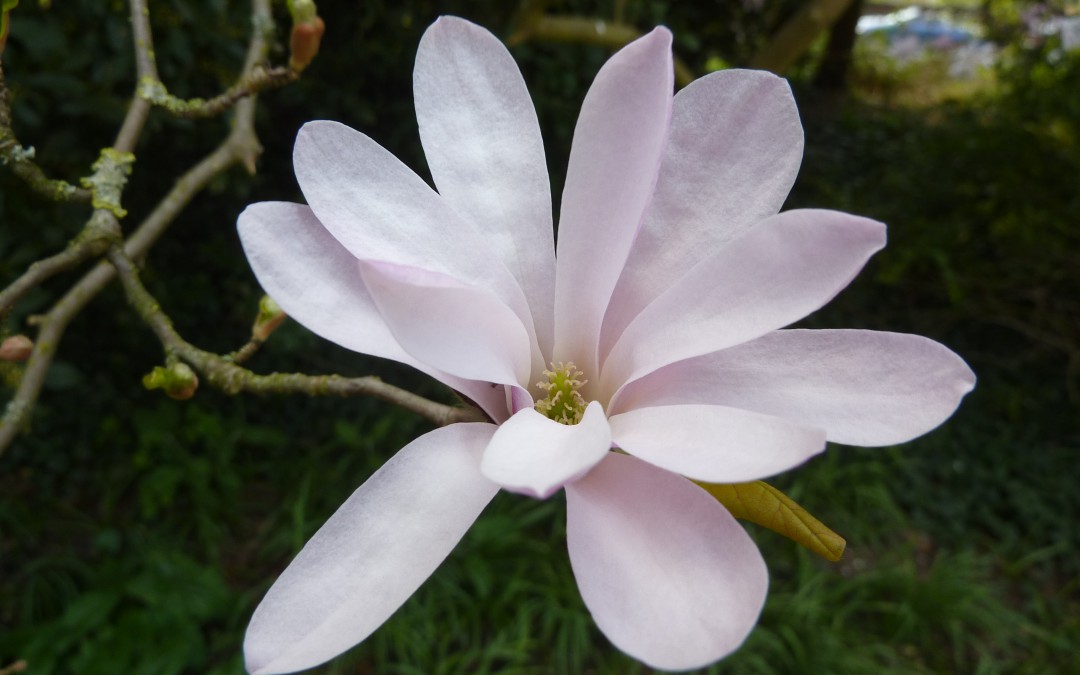With the early arrival of spring, magnolias in full bloom already dot gardens in town. The show is particularly impressive this year. Indeed, a late night frost or a heavy rain, which would have provoked a drop of the petals – tepals to be precise – on the ground and stains the remaining ones with disgraceful brown spots, have not ruined their superb flowering.
Magnolias, which originate from Asia and North America, are among the first and thus most ancient flowering trees. They have always played an important role throughout garden history, in the East first and later in the West. This is absolutely legitimate. Their natural growth habit is graceful, even magnificent with age and they do not require any pruning. In winter, they display a nice grey bark. In spring, for the varieties considered here, they flower directly on bare wood. Certain have also interesting foliage. There is no better long-term investment I could recommend.
Generally speaking, magnolias thrive in semi-shade, in an acidic to neutral soil, rich in humus. This corresponds to their natural habitat in woods. However, there exist species and cultivars that tolerate sun and in certain cases lime. Most are absolutely hardy, but late frost, which destroys their flowers, is more a source of risk in colder areas.
One usually encounters the sugary pink of Magnolia x soulangeana in town gardens. It was so fashionable at my grandparents’ generation that I find it a little bit too common. Mr. Soulange, a former Napoleon’s soldier, who dedicated his retirement to magnolias selection, raised this hybrid magnolia in the nineteenth century. This is yet another interesting career change… Nowadays there exist approximately 250 cultivars of M. x soulangeana, among which ‘Lennei Alba’, a Swiss selection dating back to the 1900’s, is still very popular with its pure white flowers.
The absolute star among all early flowering ones is certainly Magnolia campbellii. I like Louis Benech’s story about it: when he was working at Hillier nurseries, he woke up one morning, looked outside in the arboretum and could not be believe what he spotted. It was as if someone had covered during the night a tree with toilet paper… Indeed, this magnolia spots enormous flowers in a pleasant shade of pink. More than a star, Magnolia campbellii is a real diva: it is frost sensitive, even in the case of the hardier variety mollicomata and it absolutely detests lime. On top of things, it knows how to be desired, as you have to wait about 25 years to obtain the first flowers. After that, things go exponentially and you will need a large space to accommodate it. For the impatient ones or those with more reasonably sized gardens, I definitely recommend one cultivar, whose one of the parent is M. campbellii, like M. ‘Iolanthe’ or M. ‘Star Wars’.
In the early flowering ones, there is a group I particularly cherish, Magnolia x loebneri, a cross between M. kobus and M. stellata. From the latter, it has retained star-shaped flowers and it tolerates lime. I think notably of the cultivars ‘Leonard Messel’ and ‘Ballerina’ in pink or ‘Merrill’ in white. There are wonderful in double avenues along an entrance, like at Hillier’s arboretum.


Recent Comments